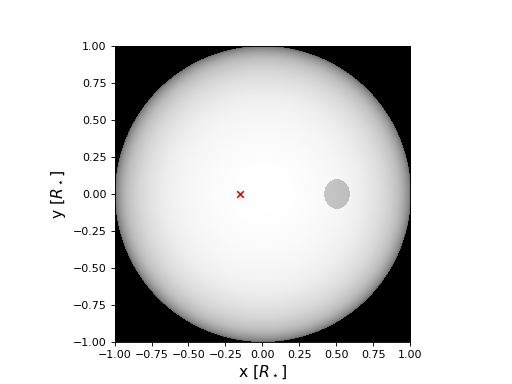Getting started¶
Contents¶
Creating a spotted star¶
Suppose you’d like to estimate the stellar centroid jitter for a star with a
spot. We begin by creating a Star object:
from mrspoc import Star
star = Star(u1=0.5, u2=0.2)
We’ve set the quadratic limb darkening parameters u1, u2 to be similar to
the Sun in the optical.
Now let’s add a Spot to the spot list attribute Star.spots, which
is placed half a stellar radius in the positive x-direction, with radius 10% of
the radius of the star:
from mrspoc import Spot
spot = Spot(x=0.5, y=0, r=0.1, contrast=0.7)
star.spots.append(spot)
The spot contrast, set to 70% here, should be interpreted as the intensity of the atmosphere in the spot as a fraction of the flux in the quiescent photosphere.
We can print the apparent stellar centroid using the
~mrspoc.Star.center_of_light attribute:
>>> star.center_of_light
(-0.0013829556756940378, 0.0)
The centroid is in the negative x direction since the spot is in the positive
x direction. We can see what this star and spot configuration look like with the
plot function:
star.plot(col_exaggerate=100)
(Source code, png, hires.png, pdf)

We’ve used the col_exaggerate keyword argument to exaggerate the centroid
offset by a factor of 100, so we can see it.
Gaia¶
mrspoc has a few handy functions for computing Gaia’s expected astrometric
precision, using the relations from
Perryman et al. 2014.
You can predict the number of times Gaia will observe a given star with
Nprime_fov, for a star at galactic latitude b:
>>> from mrspoc import Nprime_fov
>>> import astropy.units as u
>>> import numpy as np
>>> b = np.arange(0, 90, 10) * u.deg
>>> print(Nprime_fov(b))
[ 51.9 53.7 58.5 69.1 107.4 85. 71. 65.2 62.8]
The results are non-integers because they are the mean number of visits for stars near each galactic latitude.
You can compute the galactic latitude b for a target given its
SkyCoord like this:
>>> from astropy.coordinates import SkyCoord, Galactic
>>> import astropy.units as u
>>> from mrspoc import Nprime_fov
>>> coord = SkyCoord(ra=30*u.deg, dec=80*u.deg, frame='icrs')
>>> coord_gal = coord.transform_to(Galactic)
>>> print(coord_gal.b)
17d32m24.9039s
>>> print(Nprime_fov(coord_gal.b))
55.6
You can compute the expected astrometric precision on a given target as a
function of its Gaia bandpass G magnitude with sigma_fov, again
taking from Perryman et al. 2014, this time
from Equations 1-3:
>>> from mrspoc import sigma_fov
>>> sigma_fov(6.5)
<Quantity 34.2301167881504 uarcsec>
>>> sigma_fov(15)
<Quantity 81.99593485858512 uarcsec>